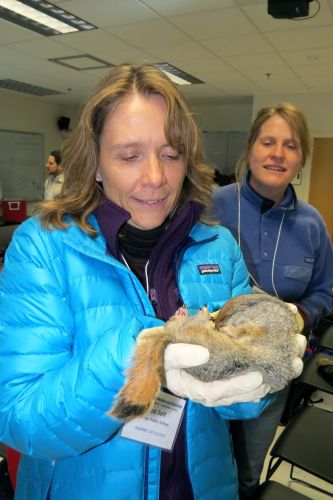To Leave Or To Hibernate, That’s The Question.
Brrrr, it’s -27º Fahrenheit or -2.7º Celsius this morning. Even with my two pairs of socks, four layers of pants and tops, wool hat and mittens, I’m still cold! How do animals in the Arctic survive the winter without freezing? “Leave or Hibernate!” explained PolarTREC research scientist Dr. Jeanette Moore from the University of Alaska Fairbanks during her presentation on Arctic Squirrel at the Museum of the North. Arctic Ground Squirrels choose to snooze through the cold! This was kindly demonstrated by the hibernating squirrel we were allowed to hold during our visit with Dr. Moore. My expectations were that it would surely awaken from it's mid-winter slumber, go running up my arm and make a squirrels nest in my hair, however it continued to lay quietly in my hand with its eyes closed. Not even the slightest sign of squirrel dreams! I was most surprised at the coldness of the squirrel as it rested in my hand, however considering the length of time it goes without eating during hibernation it makes sense that body temperatures drop to help slow down metabolism and conserve calories. Arctic Ground Squirrel temperatures can drop to -2º Celsius, with respirations of only 1 breath per minute! Wow.
 Springs School PolarTREC educator Lisa Seff holding an Arctic Ground Squirrel at the Museum of the North on the campus of the University of Alaska Fairbanks. February 11th, 2014. Photo by Susan Steiner.
Springs School PolarTREC educator Lisa Seff holding an Arctic Ground Squirrel at the Museum of the North on the campus of the University of Alaska Fairbanks. February 11th, 2014. Photo by Susan Steiner.
 Springs School PolarTREC educator Lisa Seff along with Lucy looking on, check out the Arctic Ground Squirrel at the Museum of the North on the campus of the University of Alaska Fairbanks. February 11th, 2014.
Springs School PolarTREC educator Lisa Seff along with Lucy looking on, check out the Arctic Ground Squirrel at the Museum of the North on the campus of the University of Alaska Fairbanks. February 11th, 2014.
 Dr. Steve Okkonen holds an Arctic Ground Squirrel at the Museum of the North on the campus of the University of Alaska Fairbanks. February 11th, 2014. Photo courtesy of Lisa Seff.
Dr. Steve Okkonen holds an Arctic Ground Squirrel at the Museum of the North on the campus of the University of Alaska Fairbanks. February 11th, 2014. Photo courtesy of Lisa Seff.
Through the Porthole: Compare and Contrast Assignment!
What kind of Squirrels do we have back home in Springs? Where do they live? Do they hibernate?

